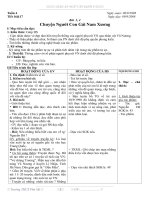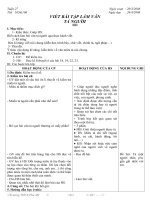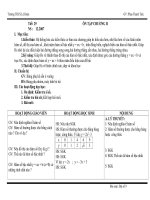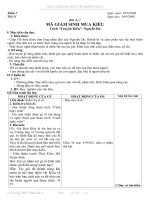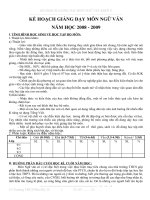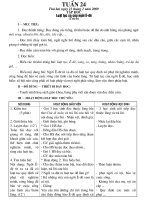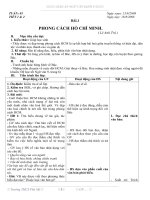giao an anh 9 tuan 4 3 cot
Bạn đang xem bản rút gọn của tài liệu. Xem và tải ngay bản đầy đủ của tài liệu tại đây (119.18 KB, 4 trang )
<span class='text_page_counter'>(1)</span><div class='page_container' data-page=1>
<b>WEEK 4:</b>
<b>Unit 2: clothing</b>
<b>Period 7: getting stared - listen and read.</b>
Date of planning: 25/8
Date of teaching:
I. Objectives:
Read a passage about the <i>ao dai</i> for general or detailed information .
By the end of the lesson students will be able to know about the traditional
dress of Vietnamese people and know the structure passive of modal verbs .
II. Language contents:
<b>1. </b>Vocabulary: poet, poetry, tunic, pant, design, fashion, inspiration, material, ethnic
minority, slit, unique, symbol, subject.
2.Structures:-Present perfect tense: to talk about an action which gegan in the past
and continues to the present
- The passive ( review) : S + be + V PII + ...
3. Skills : Speaking , Reading , Writing ,Listening
4. Knowleges: + Standard : Read and understand the passage : Know about the
design of the <i>ao dai</i> and its development .
Complete the sentences by filling the information from the text Answer the
questions about the text
+ Higher : Ask and answer some more difficult questions about the text
e<b>. </b>Education: Educate ss to learn hard and to love the beauty, the beautiful traditions
of Viet Nam
III. Materials : textbook, posters , picture of clothes .
IV.Procedure:
<b>Stage &Time</b> <b>Teacher s and Students activities</b>’ ’ <b>Work</b>
<b>arrangement</b>
1. Warm up
8’
<b>2. Pre- Reading</b>
<b>10</b>’
3. While-reading
<b>15</b>’
<b>. Getting started :</b>
<b>* Quiz :</b>
<b></b><sub> Look at the clothes people are wearing and </sub>
take turn to decide where each person comes
from and what is he/ she wearing.
<b></b><sub> Use the pictures in “Getting started” on page. </sub>
13
<b>Example :</b>
<b>T :</b> Where does the woman in picture <b>(a)</b> come
from ?
<b>S1 :</b> She comes from Japan.
<b>T :</b> How do you know she comes from Japan ?
<b>S1 :</b> Because she is wearing a Kimono.
<b>I. Pre </b>–<b> teach vocabulary :</b>
<b></b><sub> Tunic ( picture )</sub>
<b></b><sub> Lines of poetry ( poem )</sub>
<b></b><sub> ( to ) slit ( explanation )</sub>
<b></b><sub> Inspiration ( translation )</sub>
<b></b><sub> Ethnic minorities ( examples )</sub>
<b></b><sub> Unique = only</sub>
<b></b><sub> A patten ( picture )</sub>
<b>II. Listen to the tape : ( book opened )</b>
Group work
</div>
<span class='text_page_counter'>(2)</span><div class='page_container' data-page=2>
<b>4. Post-reading</b>
<b>10</b>’
<b>5. Home work</b>
2’
<b>III. Matching : a) On page. 14</b>
<b>A</b> <b>B</b>
<b>1</b> <i><b>a) poems, novels, songs</b></i>
<b>2</b> <i><b>b) to wear modern clothing at work</b></i>
<b>3</b> <i><b>c) a long silk tunic with slits up the side worn </b><b><sub>over loose pants.</sub></b></i>
<b>4</b> <i><b>d) symbols such as suns, stars, crosses, stripes</b></i>
<b>5</b> <i><b>e) lines of poetry on it</b></i>
<b>* </b>Answerkey :
<i><b>1 - a</b></i> <i><b>3 - b</b></i> <i><b>2 - c</b></i> <i><b>5 - d</b></i> <i><b>4 - e</b></i>
<b>* Broken sentences :</b> b) On page. 14
<b>A</b> <b>B</b>
1. The Ao dai is a) because it’s more
convenient
2. It was frequenly b) the traditional dress
of women
3. Many Vietnamese
women today prefer
to wear modern
clothing at work
c) inspiration on from
Vietnam’s ethnic
minorities
4. Now fashion
desgners have taken d) worn by both men
<b></b><sub> Rewrite exercises a, b ( P. 14 ) in your </sub>
notebooks.
-Prepare the next period : Speak
IV. Remark:
<b>.</b>...
<b>Unit 2: clothing</b>
<b>Period 8 </b>
<b>Lesson 2: speak</b>
Date of planning: 25/8
Date of teaching:
I. objectives:
<b>1. Knowledge: </b>By the end of the lesson, Ss will be able to say about their habit,
interest of wearing
<b> 2. Skill: </b>Listening and Speaking
II. language content:
1.Vocabulary: T- shirt, blouse, sweater, shorts, jeans, suit, plaid, plain, faded,
sleeved, sleeveless, striped, baggy.
2. Structures : - What is your favorite type of clothing? - My favorite type of
clothing is
3. Skills :<b> </b>+ Speaking : Make questions and answers about favorite type of clothing
on special occasions
</div>
<span class='text_page_counter'>(3)</span><div class='page_container' data-page=3>
+ Standard : Make and respond to the questions about favorite type of clothing
on special occasions
+ Higher : Write a passage about their favorite type of clothing
e<b>. </b>Education: Educate ss to learn hard and to know the way to wear suitably
III.Teaching aids: pictures, tapes, chalks and book
IV. Procedure:
<b>Stages &Time</b> <b>Teacher s and Students activities</b>’ ’ <b><sub>arrangement</sub>Work</b>
<b>Warm up</b>
<b>5</b>’
<b>Pre-speaking</b>
<b>10</b>’
<b>While- speaking</b>
<b>15</b>’
<b>Post-speaking</b>
<b>10</b>’
<b>* Jumble words :</b>
- T has Ss play the game
<b></b><sub> w s a e t r e ( = sweater )</sub>
<b></b><sub> e a j n s ( = jeans )</sub>
<b></b><sub> k s r i t ( = skirt )</sub>
<b></b><sub> l b o u e s ( = blouse )</sub>
<b></b><sub> s i u t ( = suit )</sub>
<b></b><sub> h i s r t ( = shirt )</sub>
<b></b><sub> a p t n s ( = pants )</sub>
<b></b><sub> h o s r t s ( = shorts )</sub>
<b>* Matching :</b>
<b></b><sub> Ask students to look the pictures and match </sub>
them with the phrases ( a ) / P. 14 – 15.
<b><sub>Answers :</sub></b>
<i><b>a) Colourful T-shirt ( 1 ) </b></i>
<i><b>d) 3 g) 7</b></i>
<i><b>b) 5 e) 8 </b></i>
<i><b>h) 2 c) 6 </b></i>
<i><b>f) 4 i) 9</b></i>
<b><sub>Check the vocabulary</sub></b><sub> : Kim’s game</sub>
<b></b><sub> Ask students to work in group of 8 or 10 </sub>
students, each read and write two more
questions for the last section of the survey
about students’ wear.
<b>* Take a survey:</b>
T: guide ss to make two next questions about
the clothes they wear on the special occasion
eg:
<i> Suggestions for asking about the clothes worn</i>
<i>on the special days</i>
+ What kind of clothes do you often wear on
the weekend?
Why do you usually wear these clothes?
+ What is your favorite type of clothing?
Why?
+ On what day do you wear school uniform?
What color is it?
+ What type of clothing do you wear on your
birthday/ at Tet ?
What would you wear to a party?
Ss: listen and try to give two more questions
T: allow ss to go around to ask their two
classmates the questions in the book to
complete the survey table
<b></b><sub> The form of survey ( box on page. 15 )</sub>
<b></b><sub> Ask students to interview their friends</sub>
T-whole class
Pair work
Group work
Group work
</div>
<span class='text_page_counter'>(4)</span><div class='page_container' data-page=4>
<b>Homework</b>
5’
<b></b><sub> Students work in group </sub>
<b>Example</b> : <b>On page. 16</b>
<b></b><sub> Ask students of each group to present the </sub>
result of the survey before the class.
<b></b><sub> Learn words in : “Jumble words”</sub>
<b></b><sub> Make a list of types of clothing that most </sub>
students in the class like wearing on different
special cases.
-Prepare for the next period: Listen
<b> Remark:</b>
...
<b> </b>
</div>
<!--links-->
